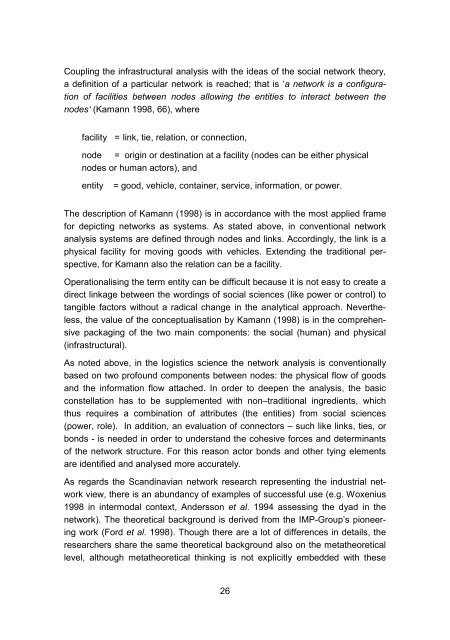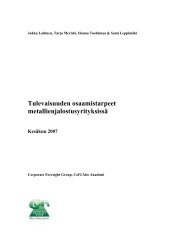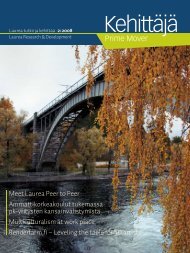849954 sisus
849954 sisus
849954 sisus
Create successful ePaper yourself
Turn your PDF publications into a flip-book with our unique Google optimized e-Paper software.
Coupling the infrastructural analysis with the ideas of the social network theory,<br />
a definition of a particular network is reached; that is ‘a network is a configuration<br />
of facilities between nodes allowing the entities to interact between the<br />
nodes‘ (Kamann 1998, 66), where<br />
facility = link, tie, relation, or connection,<br />
node = origin or destination at a facility (nodes can be either physical<br />
nodes or human actors), and<br />
entity = good, vehicle, container, service, information, or power.<br />
The description of Kamann (1998) is in accordance with the most applied frame<br />
for depicting networks as systems. As stated above, in conventional network<br />
analysis systems are defined through nodes and links. Accordingly, the link is a<br />
physical facility for moving goods with vehicles. Extending the traditional perspective,<br />
for Kamann also the relation can be a facility.<br />
Operationalising the term entity can be difficult because it is not easy to create a<br />
direct linkage between the wordings of social sciences (like power or control) to<br />
tangible factors without a radical change in the analytical approach. Nevertheless,<br />
the value of the conceptualisation by Kamann (1998) is in the comprehensive<br />
packaging of the two main components: the social (human) and physical<br />
(infrastructural).<br />
As noted above, in the logistics science the network analysis is conventionally<br />
based on two profound components between nodes: the physical flow of goods<br />
and the information flow attached. In order to deepen the analysis, the basic<br />
constellation has to be supplemented with non–traditional ingredients, which<br />
thus requires a combination of attributes (the entities) from social sciences<br />
(power, role). In addition, an evaluation of connectors – such like links, ties, or<br />
bonds - is needed in order to understand the cohesive forces and determinants<br />
of the network structure. For this reason actor bonds and other tying elements<br />
are identified and analysed more accurately.<br />
As regards the Scandinavian network research representing the industrial network<br />
view, there is an abundancy of examples of successful use (e.g. Woxenius<br />
1998 in intermodal context, Andersson et al. 1994 assessing the dyad in the<br />
network). The theoretical background is derived from the IMP-Group’s pioneering<br />
work (Ford et al. 1998). Though there are a lot of differences in details, the<br />
researchers share the same theoretical background also on the metatheoretical<br />
level, although metatheoretical thinking is not explicitly embedded with these<br />
26








